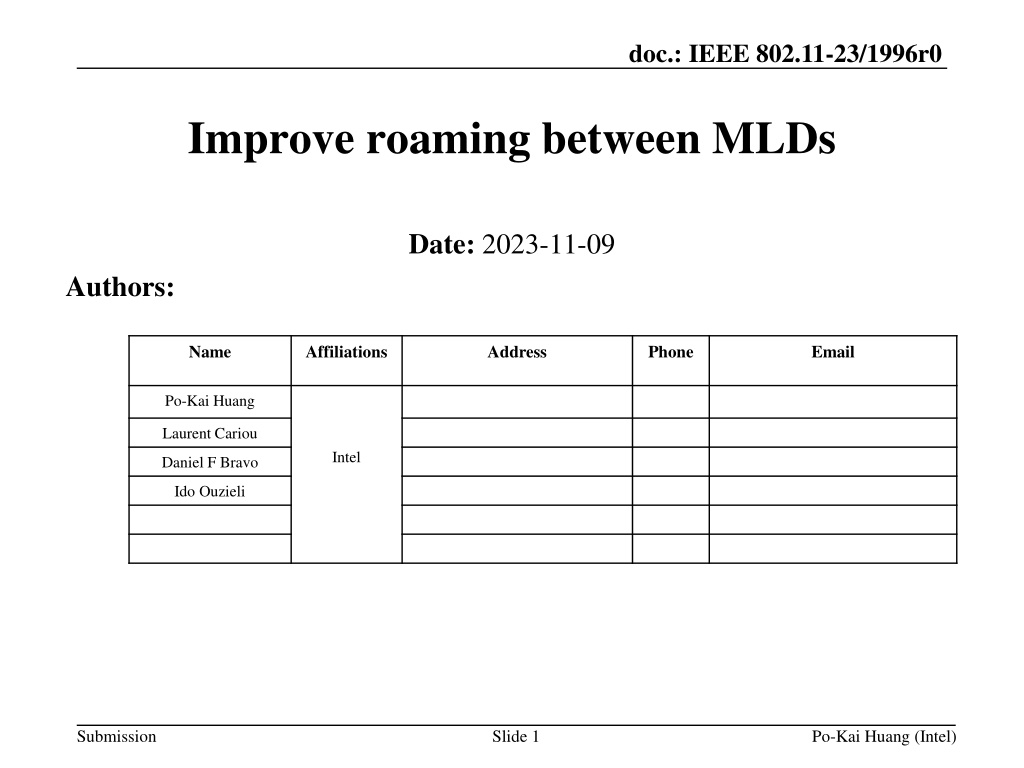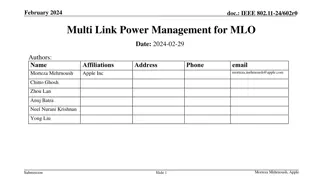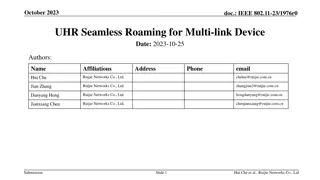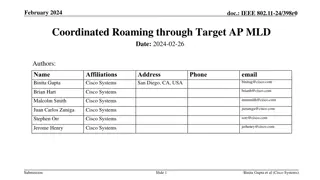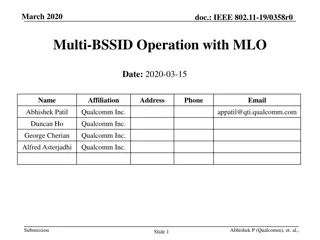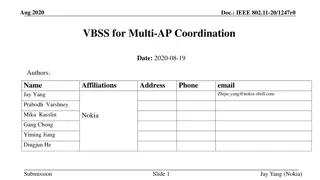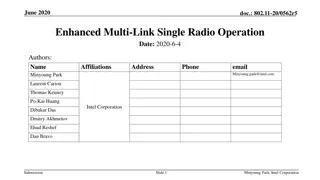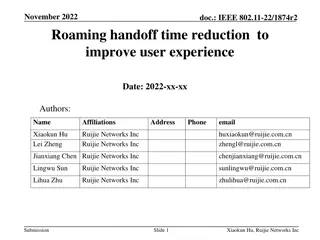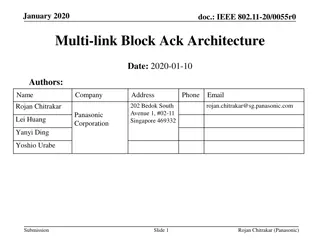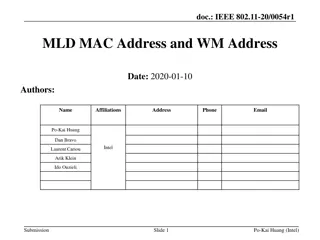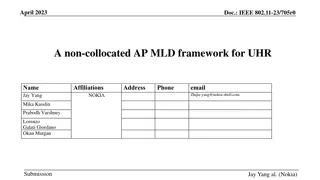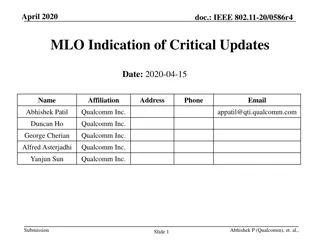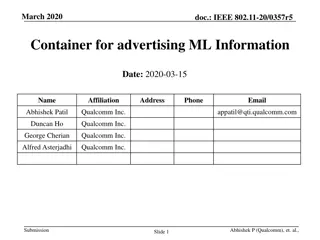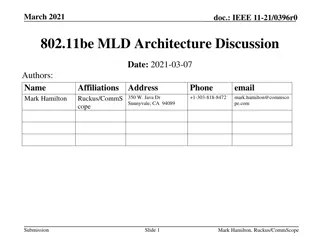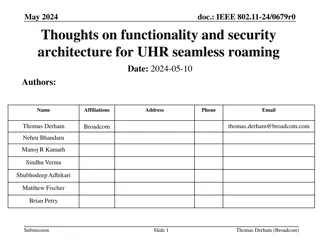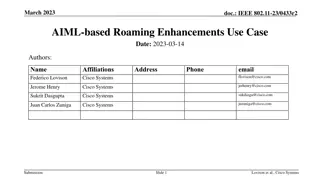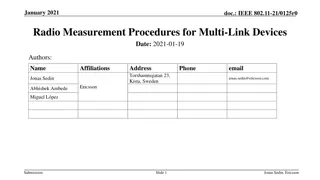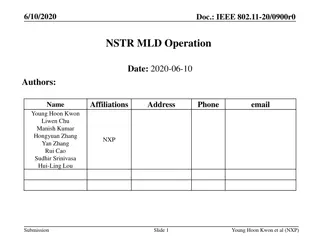Improve roaming between MLDs
Discussing realistic considerations to enhance roaming between Multiple Link Dependencies (MLDs) in IEEE 802.11-23/1996r0 to maintain data continuity and optimize performance by focusing on non-AP MLD states and data paths.
Download Presentation

Please find below an Image/Link to download the presentation.
The content on the website is provided AS IS for your information and personal use only. It may not be sold, licensed, or shared on other websites without obtaining consent from the author.If you encounter any issues during the download, it is possible that the publisher has removed the file from their server.
You are allowed to download the files provided on this website for personal or commercial use, subject to the condition that they are used lawfully. All files are the property of their respective owners.
The content on the website is provided AS IS for your information and personal use only. It may not be sold, licensed, or shared on other websites without obtaining consent from the author.
E N D
Presentation Transcript
doc.: IEEE 802.11-23/1996r0 Improve roaming between MLDs Date: 2023-11-09 Authors: Name Affiliations Address Phone Email Po-Kai Huang Laurent Cariou Intel Daniel F Bravo Ido Ouzieli Submission Slide 1 Po-Kai Huang (Intel)
doc.: IEEE 802.11-23/1996r0 Abstract We discuss how to improve roaming in [1] We highlight that it is unrealistic for the design to depend on the assumption of a central buffer to hold data of different AP MLDs for all clients associated with different AP MLDs We also highlight that it is unrealistic to assume the availability of parameter sync for different AP MLDs (ex. SN assignment) The considerations above highlight why existing MLD design can not be naively reused We provide follow up in this presentation to improve roaming with realistic consideration Submission Slide 2 Po-Kai Huang (Intel)
doc.: IEEE 802.11-23/1996r0 Goal of Roaming As described in [1], the ultimate goal is to have data continuity between two AP MLDs The first step to achieve this goal is to make sure that we do not need to redo authentication and key derivation and so on, which will break data continuity There are various steps defined in the current spec to enable data path, and a succinct way to capture this is state 4 (authenticated and RSNA established) Hence, in short, the goal of improved roaming is for the non-AP MLD to remain in state 4 (see 11.3) after successful roaming to the other AP MLD Successful Roaming Current AP MLD Target AP MLD Current AP MLD Target AP MLD State 4 State 4 Non-AP MLD Non-AP MLD Submission Slide 3 Po-Kai Huang (Intel)
doc.: IEEE 802.11-23/1996r0 Non Goal of Roaming As described in [1], parameter sync between AP MLDs is extremely hard Ex. How can two non collocated AP MLDs individually know instantaneously what is the next SN to assign? Design involves delay will make the performance even worse Some location Delay to retrieve parameter Delay to retrieve parameter Current AP MLD Target AP MLD Non-AP MLD It then makes sense to focus the data path that are not in the process of roaming to be still with one AP MLD at a time, so there is no unrealistic assumption of very fast parameter sync to maintain performance. Class 3 frames are the succinct way to capture the notion of data path in the spec Proposal: If a non-AP MLD is not in the process of roaming initiated by the non-AP MLD and the non-AP MLD is in state 4, the non-AP MLD is allowed to exchange class 3 frames with only one AP MLD Submission Slide 4 Po-Kai Huang (Intel)
doc.: IEEE 802.11-23/1996r0 Main Techniques to Improve Roaming Without parameter sync, the only way to maintain data continuity is to enable AP MLDs to do context transfer The simplest examples are keys like PMK, PTK, and parameters like next SN/PN to assigned Proposal: when a non-AP MLD is in the process of roaming from one AP MLD to another AP MLD, the context related to the non- AP MLD is transferred from one AP MLD to the other AP MLD such that it preserves the data exchange context for the non-AP MLD Context transfer Successful Roaming Initiate roaming Current AP MLD Target AP MLD Current AP MLD Target AP MLD Current AP MLD Target AP MLD State 4 State 4 Non-AP MLD Non-AP MLD Non-AP MLD Submission Slide 5 Po-Kai Huang (Intel)
doc.: IEEE 802.11-23/1996r0 How AP MLDs exchange contexts? Before we answer the question, we note that exchange context has been defined in current spec. In fast transition protocol, it is defined to allow the transfer of contexts like PMK-R1 The R0KH and the R1KH are assumed to have a secure channel between them that can be used to exchange cryptographic keys without exposure to any intermediate parties. The cryptographic strength of the secure channel between the R0KH and R1KH is assumed to be greater than or equal to the cryptographic strength of the channels for which the keys are used. This standard assumes that the key transfer includes the PMK-R1, the PMK-R1 PMKSA, the PMK-R1 context, and the associated key authorizations. The protocol for distribution of keying material from the R0KH to the R1KH is outside the scope of this standard. FT works great today! Hence, we believe that following similar principle, as a minimum, we only need to define what are the contexts to be transferred like above and leaves the protocol for distribution outside the scope of this standard Essentially, we define more contexts to be transferred, so the transition can then be even faster Submission Slide 6 Po-Kai Huang (Intel)
doc.: IEEE 802.11-23/1996r0 How the Roaming is initiated? Where to roam is ultimately determined by user using the device, i.e., the non-AP MLD It does not make sense to duplicate all the contexts to all AP MLDs all the time Waste of bandwidth Some contexts (ex next SN/PN to assign) need constantly update A straightforward approach is to define context transfer request/response for non-AP MLD to initiate context transfer from current AP MLD to target AP MLD and for non-AP MLD to be indicated the completion of context transfer and start follow up operation Submission Slide 7 Po-Kai Huang (Intel)
doc.: IEEE 802.11-23/1996r0 Conclusion We discuss how to improve roaming for 11bn with realistic implementation consideration Have a mechanism for the non-AP MLD to remain in state 4 when roam from current AP MLD to the target AP MLD Still focus on data path with one AP MLD at a time outside the roaming procedure Enable context transfer during roaming between AP MLDs Define request/response frame to initiate roaming and context transfer from current AP MLD to target AP MLD and indicate completion of context transfer Submission Slide 8 Po-Kai Huang (Intel)
doc.: IEEE 802.11-23/1996r0 SP #1 Do you support to define a mechanism in 11bn that enables a non-AP MLD to roam from one AP MLD to another AP MLD and the non-AP MLD remains in state 4 (see 11.3) after successful roaming to the other AP MLD? Submission Slide 9 Po-Kai Huang (Intel)
doc.: IEEE 802.11-23/1996r0 SP #2 Do you agree that in 11bn when a non-AP MLD is not in the process of roaming initiated by the non-AP MLD and the non-AP MLD is in state 4, the non-AP MLD is allowed to exchange class 3 frames with only one AP MLD? Submission Slide 10 Po-Kai Huang (Intel)
doc.: IEEE 802.11-23/1996r0 SP #3 Do you support to define in 11bn that when a non-AP MLD is in the process of roaming from one AP MLD to another AP MLD, the context related to the non-AP MLD is transferred from one AP MLD to the other AP MLD such that it preserves the data exchange context for the non-AP MLD? Details of the context that can be transferred are TBD How to transfer the context is TBD. Submission Slide 11 Po-Kai Huang (Intel)
doc.: IEEE 802.11-23/1996r0 SP #4 Do you support the following? Define a request frame for a non-AP MLD in state 4 to initiate the roaming procedure The roaming procedure enables context transfer between the current AP MLD and the target AP MLD Define a response frame to the non-AP MLD to indicate the completion of the context transfer and indicate readiness for the non-AP MLD to send class 3 frames to the target AP MLD NOTE - What contexts to be transferred is TBD. Submission Slide 12 Po-Kai Huang (Intel)
doc.: IEEE 802.11-23/1996r0 Reference [1] 11-23-0322 UHR Improve Roaming between MLDs Submission Slide 13 Po-Kai Huang (Intel)
